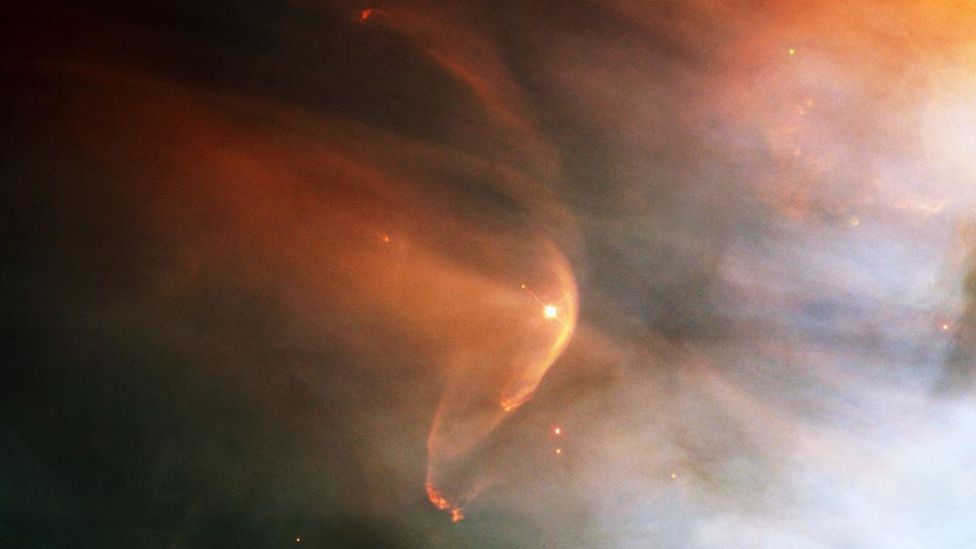
At least a few questions are now properly broached. Some day we will have it all.
What must truly ring home here is that the radiation pressure of the sun produces a halo large enough to encompass all our planets. This did not need to be true. While we are at it, what is the likely mass of the Ooart Cloud?
That is a lot of orbiting dust.
The weird space that lies outside our Solar System
(Credit: Nasa/STScI/Aura)
By Patchen Barss8th September 2020
https://www.bbc.com/future/article/20190918-is-humanity-changing-the-night-sky-with-artificial-stars
The mysterious dark vacuum of interstellar space is finally being revealed by two intrepid spacecraft that have become the first human-made objects to leave our Solar System.
F
Far from the protective embrace of the Sun, the edge of our Solar System would seem to be a cold, empty, and dark place. The yawning space between us and the nearest stars was for a long time thought to be a frighteningly vast expanse of nothingness.
Until recently, it was somewhere that humankind could only peer into from afar. Astronomers paid it only passing attention, preferring instead to focus their telescopes on the glowing masses of our neighbouring stars, galaxies and nebula.
But two spacecraft, built and launched in 1970s, have for the past few years been beaming back our first glimpses from this strange region we call interstellar space. As the first man-made objects to leave our Solar System, they are venturing into uncharted territory, billions of miles from home. No other spacecraft have travelled as far.
Magnetic fields are fighting and pushing and tied up with each other. The image you should have is like the plunge pool under Niagara Falls – Michele Bannister
And they have revealed that beyond the boundaries of our solar system lies an invisible region of chaotic, frothing activity.
“When you look at different parts of the electromagnetic spectrum, that area of space is very different from the blackness we perceive with our eyes,” says Michele Bannister, an astronomer at the University of Canterbury in Christchurch, New Zealand, who studies the outer reaches of the Solar System. “Magnetic fields are fighting and pushing and tied up with each other. The image you should have is like the plunge pool under Niagara Falls.”
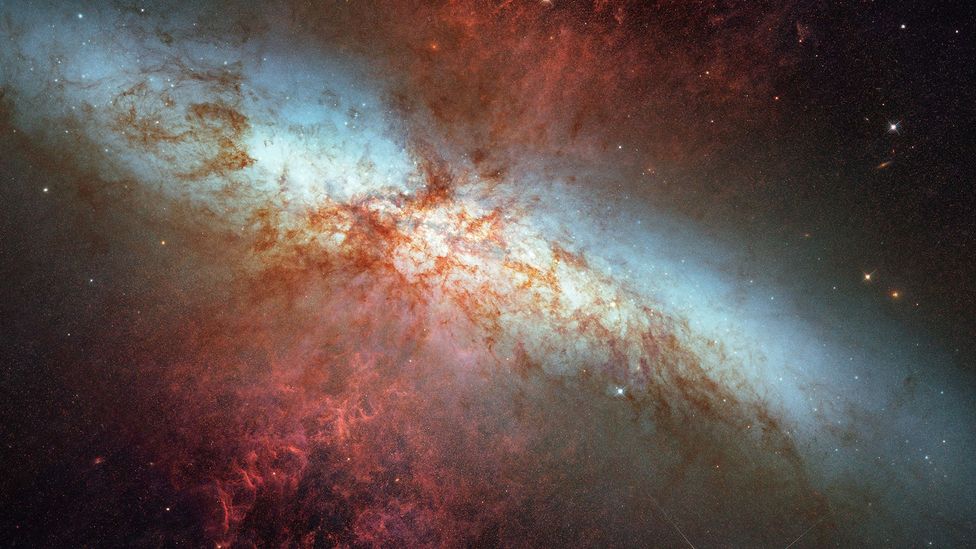
Explosions like supernova fling cosmic rays out in all directions into interstellar space (Credit: Nasa/Hubble)
Instead of tumbling water, however, the turbulence is the result of the solar wind – a constant, powerful stream of charged particles, or plasma, spraying out in every direction from the Sun – as it crashes into a cocktail of gas, dust, and cosmic rays that blows between star systems, known as the “interstellar medium”.
Scientists have been building up a picture of what the interstellar medium is made of over the past century, thanks largely to observations with radio and X-ray telescopes. They have revealed it is composed of extremely diffuse ionised hydrogen atoms, dust, and cosmic rays interspersed with dense molecular clouds of gas thought to be the birthplace of new stars.
But its exact nature just outside our solar system has been largely a mystery, principally because the Sun, all eight planets and a distant disc of debris known as the Kuiper Belt, are all contained within a giant protective bubble formed by the solar wind, known as the heliosphere. As the Sun and its surrounding planets hurtle through the galaxy, this bubble buffets against the interstellar medium like an invisible shield, keeping out the majority of harmful cosmic rays and other material.
The size and shape of the heliosphere bubble alters as we pass through different regions of the interstellar medium
But its life-saving properties also make it more difficult to study what lies beyond the bubble. Even determining its size and shape is difficult from within.
“It's like you're inside your home and you want to know what it looks like. You have to go outside and take a look to really tell,” says Elena Provornikova, a postdoctoral researcher at the Johns Hopkins University Applied Physics Laboratory. “The only way to get an idea is to travel far away from the Sun, look back, and take an image from outside the heliosphere.”
This is no simple task. Compared to the whole of the Milky Way, our Solar System looks smaller than a grain of rice floating in the middle of the Pacific. And yet, the outer edge of the heliosphere is still so distant that it took more than 40 years for the Voyager 1 and Voyager 2 spacecraft to reach it as they flew from Earth.
Voyager 1, which took a more direct route through the Solar System, passed out into interstellar space in 2012, before Voyager 2 joined it in 2018. Currently around 13 billion and 11 billion miles from Earth respectively, they are now drifting out, ever further into the space beyond our Solar System, sending back more data as they do. (Read more about Voyager, the greatest ever space mission.)
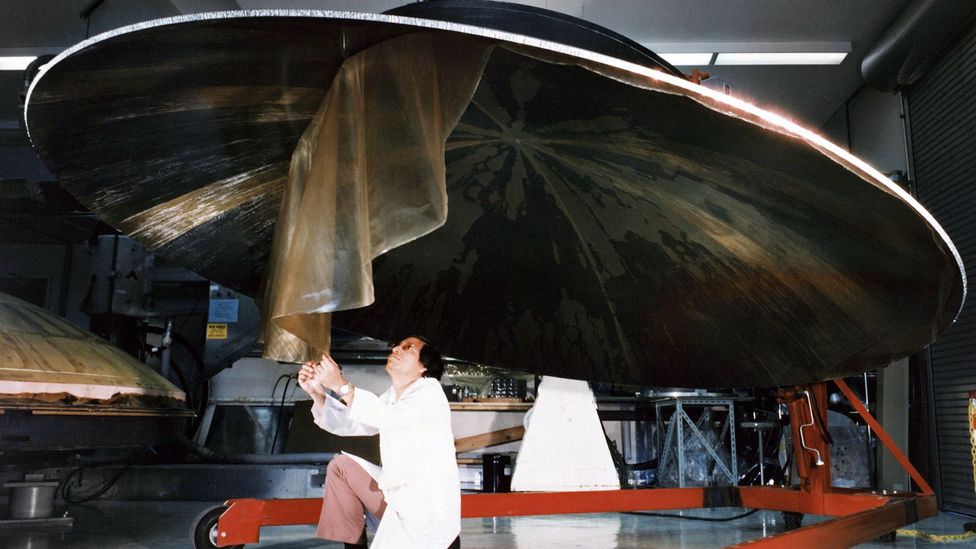
The car-sized Voyager spacecraft were launched in 1977 and are now beaming back data from interstellar space (Credit: Nasa/JPL-Caltech)
What these two aging probes revealed about the boundary between the heliosphere and the interstellar medium has provided fresh clues about how our Solar System formed, and how life on Earth is even possible. Far from being a distinct boundary, the very edge of our Solar System actually churns with roiling magnetic fields, clashing stellar windstorms, storms of high energy particles and swirling radiation.
The size and shape of the heliosphere bubble alters as the Sun’s output changes, and as we pass through different regions of the interstellar medium. When the solar wind rises or falls, it changes the outward pressure on the bubble.
In 2014, the Sun’s activity surged, sending what amounted to a solar-wind hurricane sweeping out into space. The blast quickly washed over Mercury and Venus at close to 800 km per second (497 miles per second). After two days and 150 million km (93.2 million miles), it enveloped Earth. Fortunately, our planet’s magnetic field shielded us from its powerful, damaging radiation.
The gust pushed past Mars a day later and carried on through the asteroid belt toward the distant gas giants – Jupiter, Saturn, Uranus and after more than two months, Neptune, which orbits nearly 4.5 billion km (2.8 billion miles) from the Sun.
The heliosphere is unexpectedly large, which suggests that the interstellar medium in this part of the galaxy is less dense than people thought
After more than six months, the wind finally reached a point more than 13 billion km (8.1 billion miles) from the Sun known as the “termination shock”. Here, the Sun’s magnetic field, which propels the solar wind, becomes weak enough for interstellar medium to push against it.
The solar wind gust emerged from the termination shock traveling at less than half its previous speed – the hurricane downgraded to a tropical storm. Then in late 2015, it overtook the irregularly shaped form of Voyager 2, which is about the size of a small car. The plasma surge was detected by Voyager’s 40-year-old sensing technologies, powered by a slowly decaying plutonium battery.
The probe beamed data back toward Earth, which even at the speed of light took 18 hours to reach us. Astronomers could only receive Voyager’s information thanks to a massive array of 70-metre satellite dishes and advanced technology that hadn’t been imagined, let alone invented, when the probe left Earth in 1977.
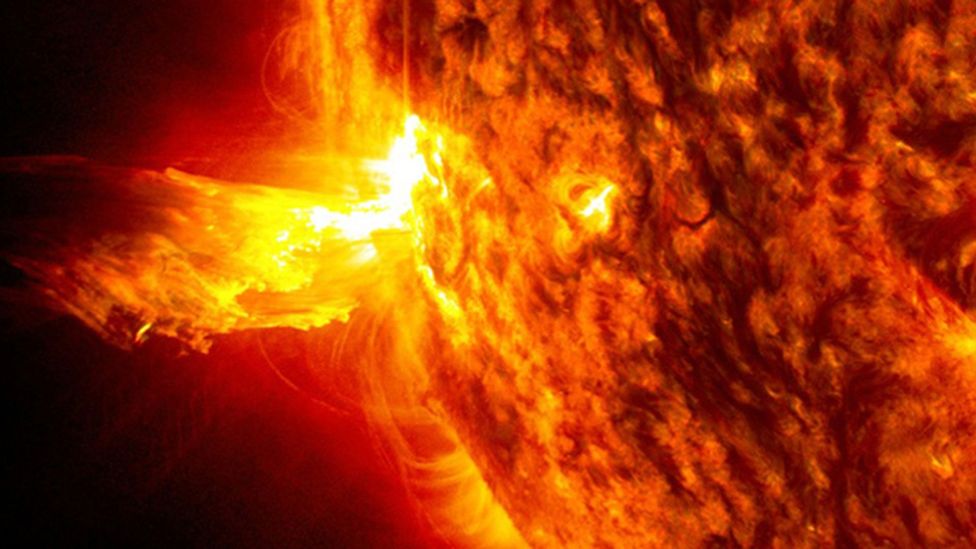
The Sun produces a constant barrage of high energy particles known as the solar wind, which can rise and fall with the activity of our star (Credit: Nasa)
The solar wind surge reached Voyager 2 while it was still just inside our Solar System. A little more than a year later, the last gasps of the dying wind reached Voyager 1, which had crossed over into interstellar space in 2012.
The different routes taken by the two probes meant one was about 30 degrees above the solar plane, the other the same amount below. The solar wind burst reached them in different regions at different times, which provided useful clues about the nature of the heliopause.
The data revealed that the turbulent boundary is millions of kilometres thick. It covers billions of square kilometres around the surface of the heliosphere.
The heliosphere is also unexpectedly large, which suggests that the interstellar medium in this part of the galaxy is less dense than people thought. The Sun cuts a path through interstellar space like a boat moving through water, creating a “bow wave” and stretching a wake out behind it, possibly with a tail (or tails) in shapes similar to those of comets. Both Voyagers exited through the “nose” of the heliosphere, and so provided no information about the tail.
“The estimate from the Voyagers is that the heliopause is about one astronomical unit thick (93 million miles, which is the average distance between the Earth and the Sun),” says Provornikova. “It's not really a surface. It's a region with complex processes. And we don’t know what’s going on there.”
A portion of the interstellar medium becomes converted to solar wind, actually increasing the outward push of the bubble
Not only do solar and interstellar winds create a turbulent tug of war in the boundary region, but particles appear to swap charges and momentum. As a result, a portion of the interstellar medium becomes converted to solar wind, actually increasing the outward push of the bubble.
And while a solar wind surge can provide interesting data, it seems to have a surprisingly small effect on the bubble’s overall size and shape. It appears that what happens outside the heliosphere matters much more than what happens within. The solar wind can wax or wane over time without appearing to dramatically affect the bubble. But if that bubble moves into a region of the galaxy with denser or less dense interstellar wind, then it will shrink or grow.
But many questions remain unanswered, including those around exactly how typical our protective solar-wind bubble might be.
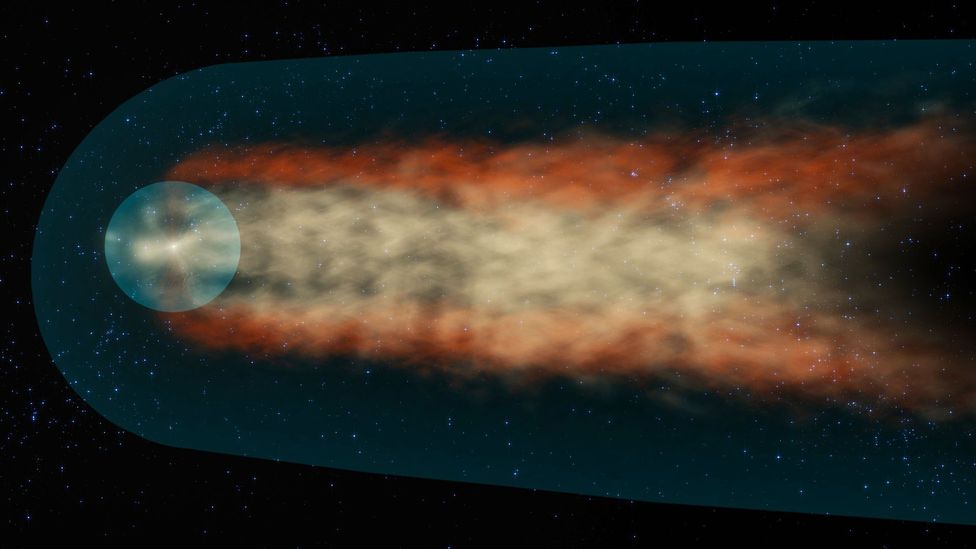
The Sun's heliosphere forms a long tail as it pushes its way through the interstellar medium on its journey around the galaxy (Credit: Nasa)
Provornikova says understanding more about our own heliosphere can tell us more about whether we’re alone in the universe.
“What we study in our own system will tell us about the conditions for the development of life in other stellar systems,” she says.
This is largely because by keeping the interstellar medium at bay, the solar wind also keeps out a life-threatening bombardment of radiation and deadly high-energy particles – such as cosmic rays – from deep space. Cosmic rays are protons and atomic nuclei streaming through space at nearly the speed of light. They can be generated when stars explode, when galaxies collapse into black holes, and other cataclysmic cosmic events. The region outside our Solar System is thick with a steady rain of these high-speed subatomic particles, which would be powerful enough to cause deadly radiation poisoning on a less sheltered planet.
Our star’s gravity extends well beyond the heliosphere, holding in place a distant, sparse sphere of ice, dust, and space debris known as the Oort Cloud
“Voyager definitively said that 90% of this radiation gets filtered out by the Sun,” says Jamie Rankin, a heliophysics researcher at Princeton University, and the first person to write a PhD thesis based on the Voyagers’ interstellar data. “If we didn’t have the solar wind protecting us, I don’t know if we’d be alive.”
Three additional Nasa probes will soon join the Voyagers in interstellar space, although two have already run out of power and stopped returning data. These few tiny pinpricks in the giant boundary will only ever provide limited information on their own. Fortunately, more expansive observation can be done closer to home.
Nasa’s International Boundary Explorer (Ibex), a tiny satellite that has orbited Earth since 2008, detects particles called “energetic neutral atoms” that pass through the interstellar boundary. Ibex creates three dimensional maps of the interactions happening all around the edge of the heliosphere.
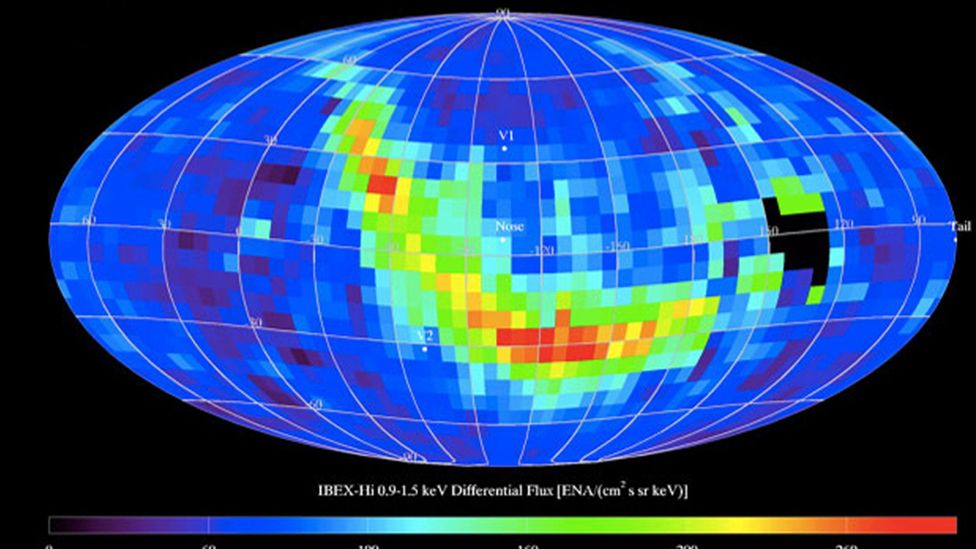
The Ibex mission has detected a ribbon of high energy atoms being reflected back from the edge of the heliosphere by the galactic magnetic field (Credit: Nasa)
“You can think of Ibex maps as sort of the ‘Doppler radar’ and the Voyagers as on-the-ground weather stations,” says Rankin. She has used data from Voyagers, Ibex, and other sources to analyse smaller surges in the solar wind, and is currently working on a paper based on the much larger blast that began in 2014. Already, the evidence shows that the heliosphere was shrinking when Voyager 1 passed the boundary, but was expanding again when Voyager 2 crossed over.
“It’s quite a dynamic boundary,” she says. “It’s pretty amazing that this discovery was captured in Ibex’s 3D maps, which enabled us to track the local responses from the Voyagers at the same time.”
Ibex has revealed just how dynamic the boundary can be. In its first year it detected a giant ribbon of energetic atoms snaking across the boundary that changed over time, with features appearing and disappearing as briefly as six months. The ribbon turns out to be a region at the nose of the heliosphere where solar wind particles bounce off the galactic magnetc field and are reflected back into the Solar System.
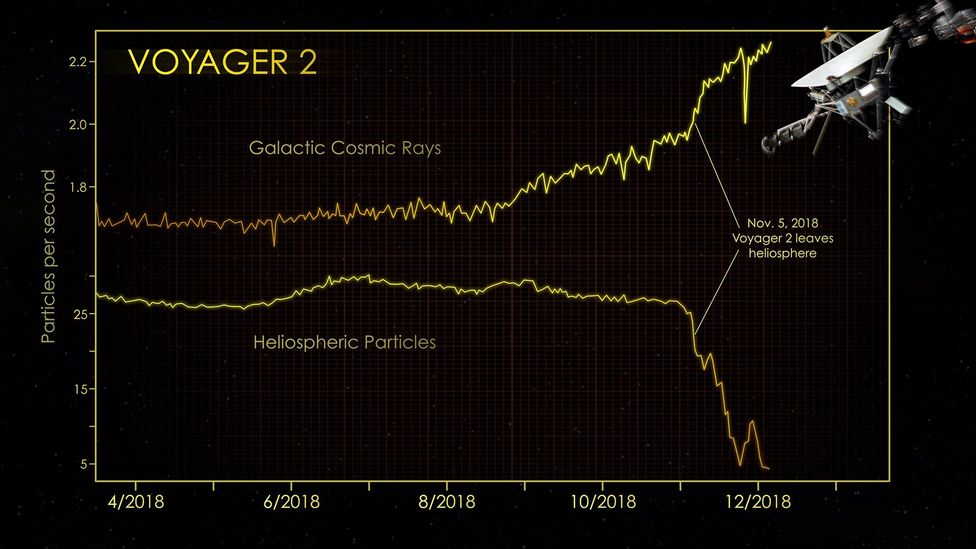
When Voyager 2 left the solar system it detected a dramatic spike in cosmic rays which the heliosphere protects us from (Credit: Nasa/JPL-Caltech/GSFC)
But there is a twist to the Voyager story. Although they have left the heliosphere, they are still within range of many of our Sun’s other influences. The Sun’s light, for instance, would be visible to the naked human eye from other stars. Our star’s gravity also extends well beyond the heliosphere, holding in place a distant, sparse sphere of ice, dust, and space debris known as the Oort Cloud.
Oort objects still orbit the Sun, despite floating far out in interstellar space. While some comets have orbits that reach all the way out to the Oort cloud, a region 186-930 billion miles (300-1,500 billion km) is generally considered too distant for us to send probes of our own.
These distant objects have barely changed since the Solar System began, and may hold keys to everything from how planets form to how likely life is to arise in our universe. And with each wave of new data, new mysteries and questions also emerge.
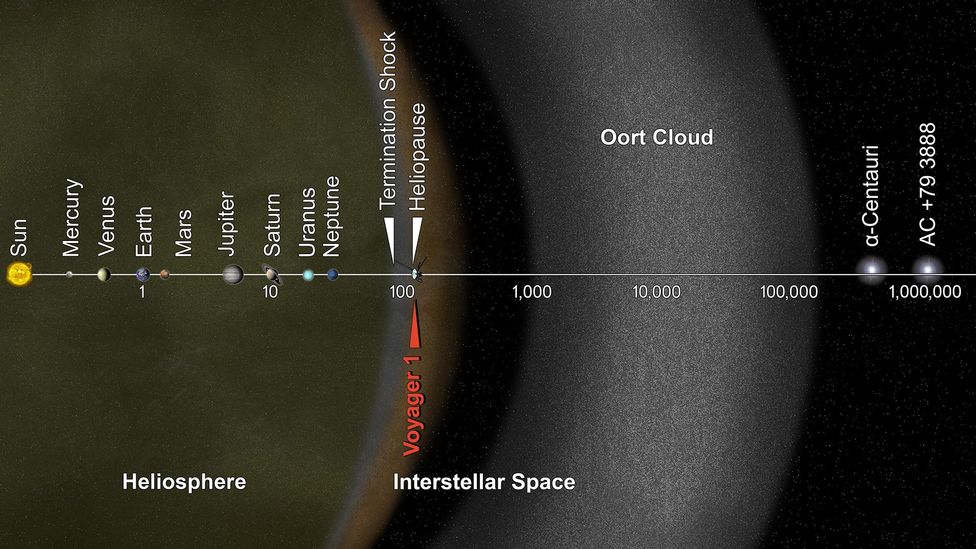
Voyager 1 crossed over into interstellar space in 2012 100 Astronomical Units from the Sun but it still has the vast Oort Cloud ahead of it (Credit: Nasa/JPL-Caltech)
Provornikova says there may be a blanket of hydrogen covering some or all of the heliosphere, whose effects have yet to be decoded. In addition, the heliosphere appears to be careening into an interstellar cloud of particles and dust left over from ancient cosmic events whose effects on the boundary – and on those of us who live within it – have not been predicted.
“It could change the dimensions of the heliosphere, it could change its shape,” says Provornikova. “It could have different temperatures, different magnetic fields, different ionisation and all these different parameters. It’s very exciting because it’s an area of many discoveries, and we know so little about this interaction between our star and the local galaxy.”
Whatever happens, two car-sized assortments of metal bolted to small parabolic dishes – the intrepid Voyager probes – will be our Solar System’s vanguard, revealing ever more about this strange and uncharted territory as we plough onwards through space.
--
No comments:
Post a Comment